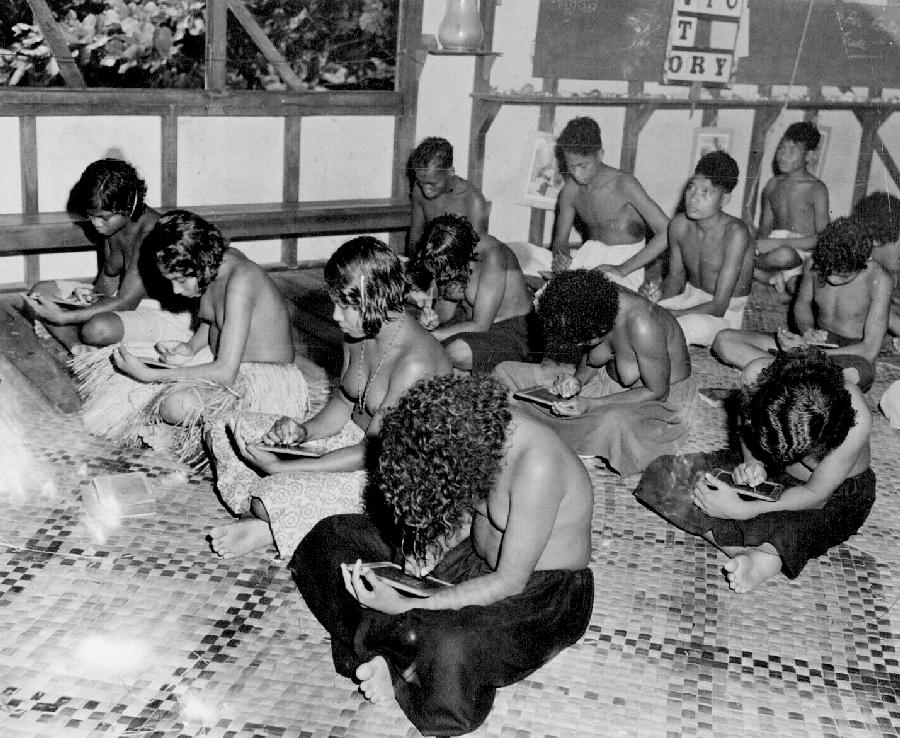
Australian Air Defenes in New Guinea: Hood Point (1942)

Figure 1.--The New Guinea campaign was the longest American campaign of Workd War II (1942-44). As a result, articles about New Guinea began to appear in American newspapers. Here we see a mission school at Hood Point the location of an emergency air strip near Port Moresby. The press caption read, "Three R's in New Guinea: Their heads bent overslates, dusky children of Hood Point village, New Guinea, apply themselves to their lessons at the school run by Rev. Harold James Edward Short. In this class, about 70 children squat on clean , straw matting and learn their readin, ritin, and rithmetic. Note the block-letter 'Victory' at right background." The photograph was datedbKuly 30, 1943. Fighting was still going on along the northern coast. .
|
|
The Australians built an emergency air strip at Hood Point a few miles west of Port Moresby in Papua New Guinea. It was near Hula village and also cakked the Huna Beach Air Strip. The emergency ai strip was active at the time of World War II. They strip was used by U.S. Arny Air Corps and the Royal Australian Air Force (RAAF). American transports were arriving in Australia with supplies, equioment, and aircraft. Slowly Australian air defences were bbeing beefed up. Hood Point has several villages; Hula, Alewai, Irupara, Makerupu, Kamali and Babaka. American P-39 Airacobras led by Lt. Col Boyd D. “Buzz” Wagner conducted a strafing mission against the Japanese Lae Airfield on the northern coast of New Guinea. It was the 8th Fighter Group’s first combat mission. They flew from 7-Mile Drome (now Jacksons Airport) near Port Moresby
(April 30, 1942). They hit parked aircrafts and seaplanes. Japanese A6M2 Zeros of the Tainan Kōkūtai scrambled and engaged the Airacobras. One of the Airacobra crash landed on the Rakili beach near Hood Point.
The pilot, Captain Brown was taken to Abau where he met Japanese prisoner of war Yoshimitsu Maeda, pilot of the A6M2 Zero 1575 who had crash landed nearby (April 28). Both were transported aboard the MV Matoma to Port Moresby. Captain Brown later returned to duty with his squadron (early May).
Two other aircraft that force landed at Kalo village also near Hood Point was a P-40E, piloted by a Lieutenant Finberg and a P-40 Waryhawk piloted by 1st Lt. William F. Haning Jr (November 17, 1942). This P-40 was operating from Darwin, Port Moresby and Milne Bay.
Lt Finberg took off on an escort mission protecting C-47 transports flying to Pogani Airfield and on the return flight, bad weather forced him to ditch his P-40E Warhawk into the sea near Hula.
Haning had been escorting Australian Beaufighters on a mission to Zaka near Morobe when bad weather caused him to become lost on the return flight, subsequently running out of gasoline and making a safe crash-landing near Hood Point. On the ground, Haning fired his guns to keep the locals away from the aircraft, because he feared it might catch fire after the landing. Haning was unhurt in the landing and was later transported to Port Moresby and returned to his squadron on Nov 22, 1942.
CIH -- WW II

Navigate the CIH World War II Section:
[Return to Main Coral Sea campaign page]
[Return to Main World War II naval campaign page]
[Return to Main World War II South Pacific campaign page]
[Return to Main World War II page]
[About Us]
[Aftermath]
[Biographies]
[Campaigns]
[Children]
[Countries]
[Deciding factors]
[Diplomacy]
[Geo-political crisis]
[Economics]
[Home front]
[Intelligence]
[POWs]
[Resistance]
[Race]
[Refugees]
[Technology]
[Totalitarian powers]
[Bibliographies]
[Contributions]
[FAQs]
[Images]
[Links]
[Registration]
[Tools]
[Return to Main World War II page]
[Return to Main war essay page]
[Return to CIH Home page]
Created: 5:02 AM 4/3/2019
Last updated: 5:02 AM 4/3/2019



